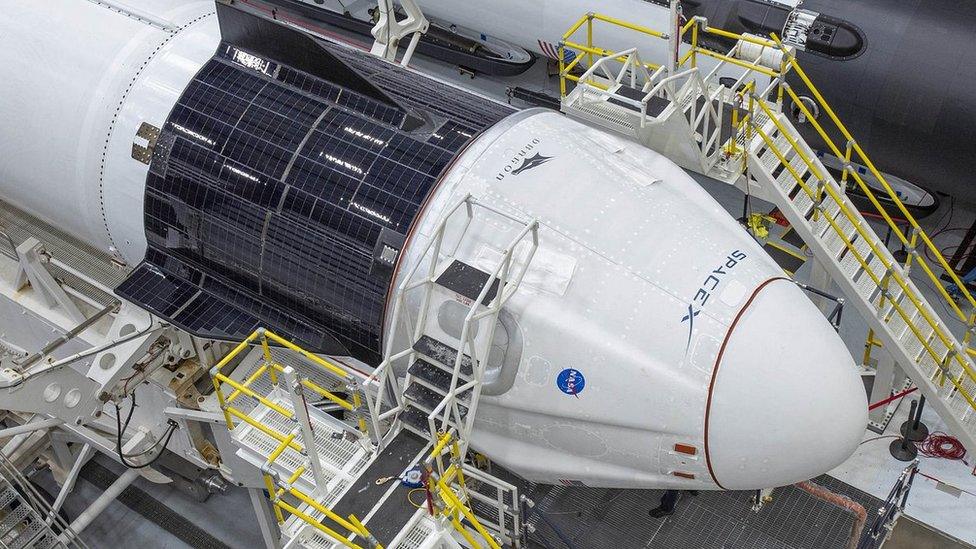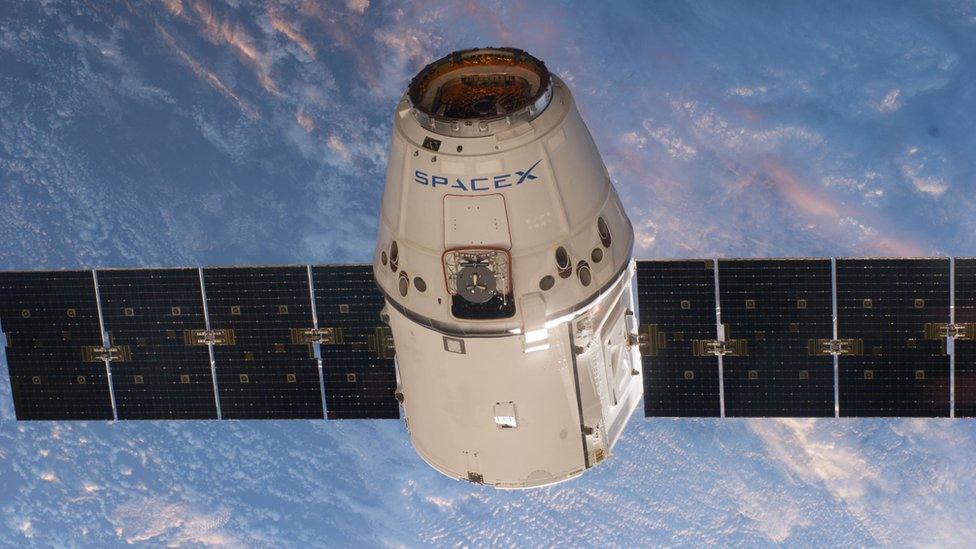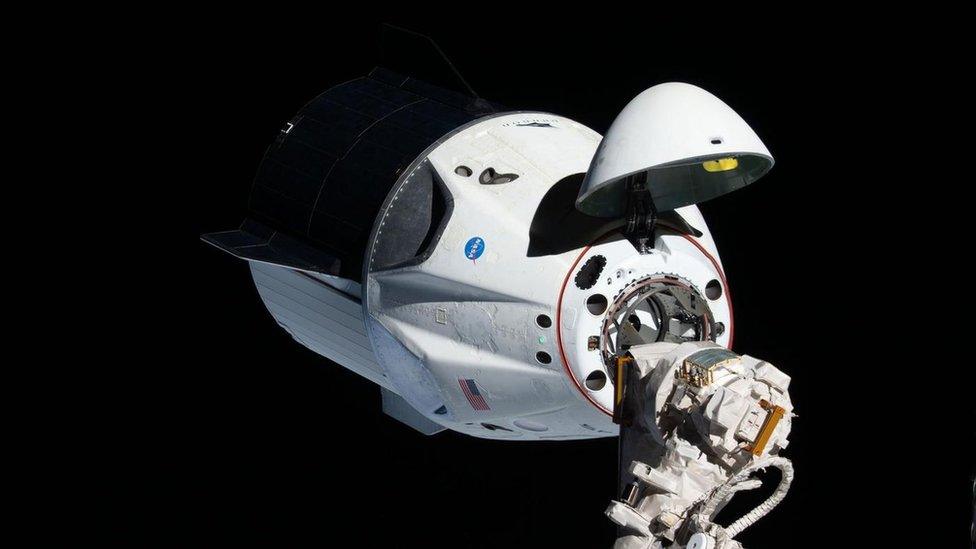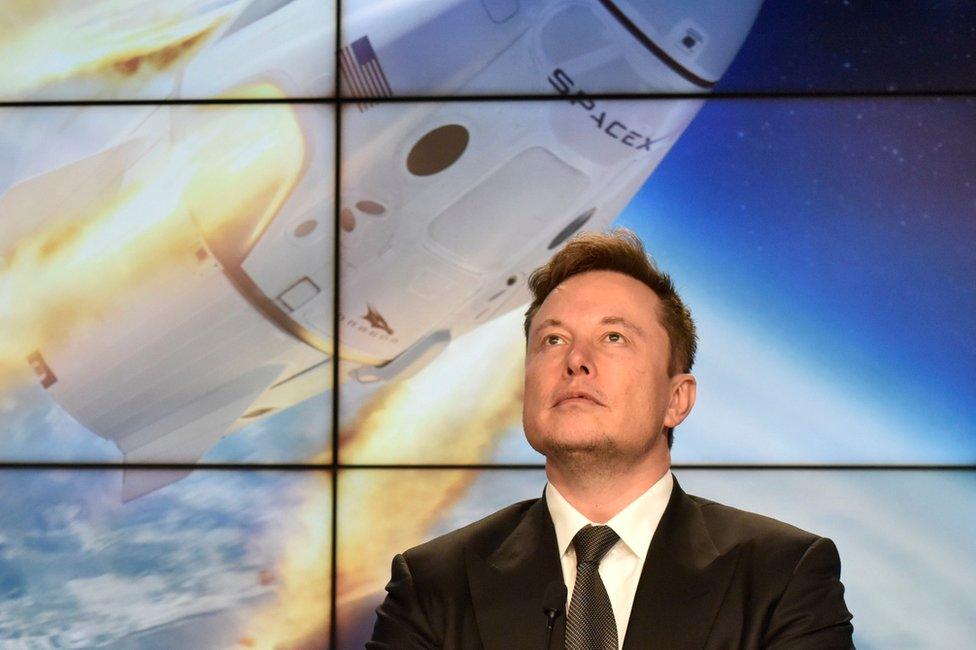Why Elon Musk's SpaceX is launching astronauts for Nasa
- Published

Elon Musk's SpaceX is flying people to and from the International Space Station (ISS), using the Crew Dragon vehicle. But why is Nasa paying a private company to launch its astronauts?
To understand the background to the Crew Dragon missions, we need to go back almost 20 years to a tragic accident.
On 1 February 2003, the space shuttle Columbia broke apart while re-entering the Earth's atmosphere. All seven astronauts aboard perished in the disaster.
The loss of Columbia and its crew was the trigger for a dramatic shift in direction for America's human spaceflight programme.
On 14 January 2004, President George W Bush announced that the space shuttle would be retired after completion of the International Space Station (ISS). In its place, America would build a new vehicle capable of returning astronauts to the Moon.

Artwork: Nasa conceived of the Orion spacecraft as a replacement to the shuttle
The following year, then-Nasa chief Mike Griffin announced that the completion of the ISS would, for the first time, open up commercial opportunities for the routine transportation of cargo and astronauts to low-Earth orbit.
This, Griffin reasoned, was required to free up enough funds to achieve a Moon return. Nasa established a Commercial Crew & Cargo Program Office (C3PO) to oversee the effort.
At the time, SpaceX, the company started by South African-born entrepreneur Elon Musk was just a few years old. Musk had lofty ambitions about bringing down the cost of spaceflight by re-using space hardware and settling humans on Mars.
"SpaceX was founded to make life multi-planetary," says Jessica Jensen, director of Starship mission hardware and operation at SpaceX.
But, she adds: "We were a very small company for several years. So we had to look for opportunities - how do you go from being a small company to actually putting people into orbit. When Nasa came out with the need to fly cargo to and from the International Space Station, we jumped on that."

The Dragon 1 spacecraft was designed to carry cargo to and from the space station
SpaceX was shortlisted for evaluation under the Nasa cargo programme in 2006. But by 2008, SpaceX and Tesla, the electric car manufacturer in which Musk had invested, were running low on cash. Musk was faced with an impossible choice: "I could either split the funds that I had between the two companies, or focus it on one company - with certain death for the other," he told Business Insider in 2013., external
"I decided in the end to split what I had and try to keep both companies alive. But that could have been a terrible decision that could have resulted in both companies dying."
Fortunately, on 23 December 2008, Nasa awarded SpaceX with a $1.6bn contract to ferry cargo and supplies to the ISS. Describing his reaction, Musk said: "I couldn't even maintain my composure, I was like: 'I love you guys'."
The company's Dragon 1 capsule could carry cargo and supplies, but not humans. Nevertheless, it represented a milestone for the company.
In November 2008, Barack Obama had been elected president. His administration kicked off a review of the human spaceflight programme, which led to the cancellation of his predecessor's plan to return to the Moon (known as Constellation).

SpaceX performed a successful flight to the space station without crew in 2019
However, the Obama administration favoured the continued commercialisation of space, backing the development of private crew vehicles. But it would take time and, after the space shuttle was retired, Nasa had to fill the gap by paying Russia tens of millions of dollars per seat to fly its astronauts to the ISS on the Soyuz vehicle, which launches from Baikonur in Kazakhstan.
Congress was initially sceptical about the Commercial Crew Program and did not provide sufficient funds at first. But Charles Bolden, the former astronaut who took over from Griffin as Nasa chief under Obama, persisted and eventually secured the support he needed.
From their initial $50m investment in the programme in 2010, the space agency whittled several competing companies down to two - SpaceX and Boeing - in 2014.
Since then, they have been refining and testing their spacecraft designs.
In March 2019, SpaceX performed a triumphant launch of the Crew Dragon without astronauts. Using automated procedures, the capsule successfully approached and docked with the space station.
It was carrying a mannequin called Ripley - after Ellen Ripley, the protagonist in the Alien movies - decked out with sensors to measure the G forces experienced during flight, particularly the launch and return phases.

Elon Musk founded SpaceX in 2002 with the aim of taking humans to other planets
Despite this success, and others along the way, it hasn't always been plain sailing for SpaceX. In 2016, a Falcon 9 rocket blew up on the launch pad. And in April 2019, a Crew Dragon capsule exploded during a so-called static fire test on the ground. No one was hurt in either event.
The spacecraft was also having problems with the parachute system designed to bring it back safely to Earth.
These mishaps, along with earlier funding shortfalls for the Commercial Crew Program, external, had introduced delays to an original timeline that would have seen SpaceX launch crew to the ISS in October 2016.
Frustrated by the hold ups and the time SpaceX was spending on its Starship project to build a super heavy-lift launch vehicle, Nasa administrator Jim Bridenstine tweeted:
Allow X content?
This article contains content provided by X. We ask for your permission before anything is loaded, as they may be using cookies and other technologies. You may want to read X’s cookie policy, external and privacy policy, external before accepting. To view this content choose ‘accept and continue’.
Bridenstine sent the tweet the night before a major Starship media event where Musk was due to speak.
The next day, Musk shot back with a dig at the agency's own timelines. Asked about the tweet by CNN, Musk answered: "Did he (Bridenstine) say Commercial Crew or SLS?"
The SpaceX founder was referring to Nasa's Space Launch System rocket - designed to launch humans to the Moon - which has also been hit by delays and cost overruns.
Musk's company wasn't alone in experiencing challenges, however. A timing anomaly prevented Boeing's spacecraft - the CST-100 Starliner - from docking with the space station during an uncrewed test flight last year.
"Go Nasa, go SpaceX. God speed Bob and Doug"
However, a successful in-flight test of the Crew Dragon's launch abort system in January 2020 helped clear the way for the historic first lift-off with astronauts from Florida's Kennedy Space Center on 30 May.
Nasa's Doug Hurley and Bob Behnken spent two months aboard the ISS before returning to Earth safely in the capsule.
In the post-launch press conference, both Bridenstine and Musk struck more conciliatory tones, in contrast to the tensions over the Starship project.
"If you would have told me then (eight months prior, when he sent the tweet) that we would be right here today, I don't know that I would have believed it," said Bridenstine.
"Since that day, Elon Musk and SpaceX have delivered on everything Nasa has asked them to deliver on - and at a speed that we never would have guessed."
The Nasa chief also congratulated SpaceX on its safety culture. Musk replied: "Nasa made us way better than we would otherwise have been - and of course, we couldn't even have got started without Nasa."
Follow Paul on Twitter., external